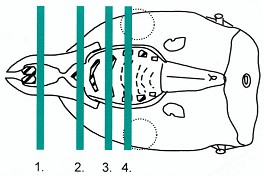
Nasal cavity, rat, 4 trimming locations.
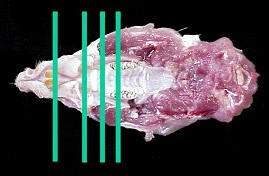
Nasal cavity, rat, 4 trimming locations.
| Species: | Rats and Mice |
| Organs: | Nasal cavity Nasopharynx Paranasal sinus |
| Localizations: | 1) Posterior part of upper incisors 2) Incisive papilla 3) Second palatine crest 4) First molar teeth |
| Number of sections: | 1 (oral toxicity study: third level) 4 (inhalation study) |
| Direction: | Transverse |
| Remarks: | Embedded with the rostral faces down Decalcified |
 Nasal cavity, rat, 4 trimming locations. |
 Nasal cavity, rat, 4 trimming locations. |
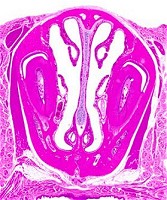 Nasal cavity, rat, location 1. |
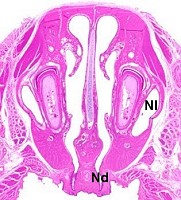 Nasal cavity, rat, location 2. Nd: nasopalatine (incisive) duct, Nl: nasolacrimal duct. |
 Nasal cavity, rat, location 3. Ps: paranasal sinus. |
 Nasal cavity, rat, location 4. Pd: pharyngeal duct (nasopharynx). |
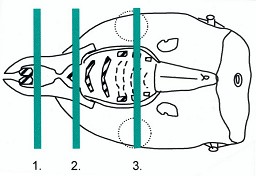 Nasal cavity, mouse, 3 trimming locations. |
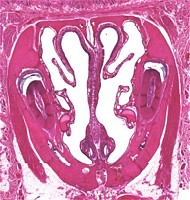 Nasal cavity, mouse, location 1. |
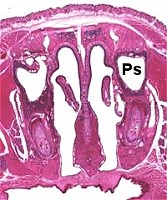 Nasal cavity, mouse, location 2. Ps: paranasal sinus. |
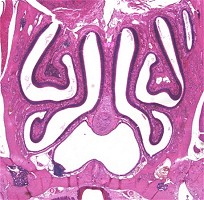 Nasal cavity, mouse, location 3. |
The structures of the palate and the teeth are used for orientation to achieve transverse sections through the nasal cavity at certain levels.
In inhalation studies, four transverse tissue levels should be taken, because the examination of these sections at defined levels assures consistent recognition of degenerative and proliferative lesions of all different epithelial cell types of the nasal cavity and paranasal sinus. Typically in oral toxicity studies, only the third level is examined. Neoplastic lesions occur more frequently in the anterior and middle portions of the nasal cavity, whereas some non-neoplastic and neoplastic lesions are observed exclusively in the olfactory epithelium. The third level includes respiratory and olfactory epithelial cells. The resulting slices of tissue are embedded with the rostral face down, because non-neoplastic lesions have been found to be most severe at the more rostral borders of the affected epithelium. Slight differences of the cut level may occur depending on anatomical variations in different strains.
If more squamous epithelium is required for examination, a section rostral to level 1 should be performed. For examination of the olfactory bulb, a section caudal to level 4 is recommended.
Relevant differences between rats and mice
Mice should be trimmed in the same manner as rats. However, in inhalation studies with very young or very small mice (e.g., transgenic strains), it can be difficult to cut the nose in four levels. For those exceptions, the following three level-procedure is recommended:
1) Immediately posterior to the incisors,
2) At the level of the incisive papilla,
3) Through the middle of the second molar tooth.
For non-inhalation studies level 3 is recommended for examination.
See also:
Introduction
|
Trm V 5.00 |
Reference: Kittel B, Ruehl-Fehlert C, Morawietz G, et al. (2004) Revised guides for organ sampling and trimming in rats and mice – Part 2. A joint publication of the RITA and NACAD groups. Exp Toxic Pathol 55: 413–431 |